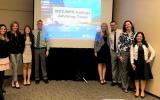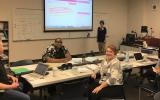Access
October
2021
College students who are parents, a.k.a., student-parents, have always been enrolled in community colleges, but only within the past few years have they been explicitly recognized as a distinct student group with a unique set of support needs. According to the Institute for Women’s Policy Research (2018), more than one in five postsecondary students in the U.S. is a student-parent. This holds true at Monroe Community College (MCC), where 21.4 percent of students enrolled in 2019-2020 had children under age 18 (DeMario, 2021).
Student-Parent Risk Factors
Figure 1 shows that MCC’s student-...
Tags:

Johnson County Community College (JCCC) has partnered with Butler Community College (BCC) to offer expanded training in culinary arts. This opportunity allows JCCC to extend the benefits of its Chef Apprenticeship program to more Kansas students. In turn, the collaboration strengthens state and local workforce opportunities.
Through this agreement, BCC is offering two additional certificates to students in South Central Kansas. The new certificate options use existing BCC culinary courses with the addition of practicum courses from JCCC. Along with invaluable industry training, students in...
Tags:

For decades, Jackson College (JC) has been a U.S. leader in providing higher education access and opportunity to incarcerated students. The town of Jackson, Michigan, has long been known as a “prison city,” and three large correctional facilities are located less than 15 miles from JC’s Central Campus. In 1967, the college offered its first class “inside the walls.” In 1969-1970, a pilot prison education program for the Southern Michigan Prison was launched to provide qualifying inmates an opportunity to further their education.
Jackson Community College (as it was then called) was one of 26...
Tags:

Almost half of U.S. community college students responding to the #RealCollege survey conducted by The Hope Center for College, Community and Justice indicated that they had experienced food insecurity within the 30 days before completing the survey (Goldrick-Rab et al., 2019). In response, an increasing number of community colleges are working to eliminate food insecurity for students and their families. Through programs such as on-campus food pantries, community gardens, farmers’ markets, and food scholarships, colleges are finding solutions for students and, in some cases, staff who are...

In fiscal year 2019-2020, Sinclair Community College (Sinclair) received $10,000 from StrivePartnership Cincinnati and Learn to Earn Dayton to develop and implement a strategic communication plan to reach students who had stopped out in the previous two years without completing a degree from any postsecondary institution. Sinclair chose to expand their reach beyond the originally funded 2,000 students to include an additional 6,300 students who had stopped out in the previous five years. The communication strategy consisted of a combination of intentional personalized phone calls, email, mail...

Rio Salado College is one of 67 postsecondary institutions to be included in an expansion of the U.S. Department of Education’s Second Chance Pell Experimental Sites Initiative. One-hundred and thirty colleges in 42 states and the District of Columbia will now be involved in this initiative, which provides need-based Pell grants for people incarcerated in state and federal prisons to pursue higher learning. The majority of incarcerated individuals are Pell-eligible, but they have been banned from applying for assistance since 1994 as a result of the 1994 Violent Crime Control and Law...
Tags:

Like many newcomers to Canada, Malvika Mahajan immigrated to Toronto to find a better life for her family. She was anxious about restarting her career in a new country, despite having many years of experience as a supply chain specialist in India, including work for a large multinational corporation. To create a roadmap that would land her a professional role in Canada, Malvika joined the Supply Chain Management bridging program at Humber College Institute of Technology and Advanced Learning in January 2020, eager to learn as much as possible about how her field operates in Canada and to...

San Diego Mesa College is partnering with San Diego Unified School District, San Diego State University (SDSU), and National University to mold a new generation of K-12 educators from diverse backgrounds who reflect the students they teach. The Teacher Pathway Inclusion Program was launched in April 2019 and includes a bevy of support services to create a seamless route for high school students to earn a bachelor of arts degree and teaching credential, with an emphasis on filling a growing need in science, mathematics, and special education. Mesa College aims to enroll 50 students...

Founded by the National Science Foundation (NSF) in 2013, the Center for Laser and Fiber Optics Education (LASER-TEC) faced a new challenge as the spread of COVID-19 impacted LASER-TEC institutions. Headquartered at Indian River State College (IRSC) in Fort Pierce, Florida, LASER-TEC is comprised of colleges, universities, high schools and technical centers, trade associations, and laser and fiber optics companies throughout the United States. The center’s mission is to develop and sustain a strong technical workforce in lasers and fiber optics nationwide. Remaining committed to that goal,...
Tags:

Phoenix College (PC), one of ten colleges in the Maricopa County Community College District (MCCCD), was established in 1920. Located in the heart of Phoenix, Arizona, PC is one of the oldest community colleges in the United States, serves more than 17,000 students annually, and is designated by the Department of Education as a Hispanic-Serving Institution (HSI). The college opened its doors during a period of racial unrest and was one of the only institutions to support a diverse student body at that time. Today, PC remains a staple in the community as a social justice-conscious college,...
Tags:

Leadership at Mesa Community College (MCC) and Mesa Public Schools (MPS) worked together to strategize methods to increase persistence and college attendance for high school students, with an emphasis on populations facing the most challenges. The resulting Mesa Community College High School Advisor Program creates a one-stop enrollment experience and is increasing the number of Mesa public high school students enrolling at the college.
Through the partnership, an MCC college advisor is embedded in each of the six MPS high schools to recruit students, provide seamless transition to MCC,...

Researchers define a first-generation student as the first member of a family to attend college (Chen, 2005; Ishitani, 2006; Redford & Mulvaney Hoyer, 2017). In the U.S., these students are more likely to be African American or Hispanic (Chen, 2005), come from a lower socioeconomic status (Jenkins, Miyazaki, & Janosik, 2009; Redford & Mulvaney Hoyer, 2017), and have a higher rate of attrition at the collegiate level than their counterparts (Chen, 2005; Lohfink & Paulsen, 2005; Nuñez & Cuccaro-Alamin, 1998). Students who are first-generation as well as low-income are at a...

Like most community colleges across the U.S., Kirkwood Community College embodies the widely celebrated educational ideal that it’s never too late to get a college education. This ideal is on display every day at 10 campuses spread out over the college’s seven-county service area in eastern Iowa. In fact, the age range for enrolled, degree-seeking students at the college is from 16 to 74 years old, and that range grows even wider when dual enrollment numbers are considered.
When Kirkwood first opened its doors in 1966, the educational delivery format was the same for every student, no matter...

Made possible through a new partnership between the Maricopa County Community College District and GED Testing Service, Rio Salado College students can now use their GED scores to demonstrate college readiness and college-level skills. The GED College Ready and College Ready + Credit scores are based on recommendations from the American Council on Education (ACE) Credit Program, the same program that backs CLEP and other advanced placement testing college credit recommendations. As is the case with these other programs, students may be eligible to receive college credit for courses aligned...
Tags:

Students in the Mesa Community College (MCC) Everyone Can Code iOS Apple App Development program decided that a joint project was a perfect opportunity to put their knowledge to use. The outcome? The Resource Information Services for Everyone (RISE) app.
The development team of faculty and nine students from advanced and introductory classes were assigned roles that highlighted their skills. The team researched the existing app market, developed a plan, and began developing a proof of concept. Initially, the app contained helpful markers for on-campus resources such as registration,...

Community colleges enroll over half of the undergraduate students in U.S. higher education and increasingly serve as the gateway to a postsecondary credential, particularly for first-generation and underrepresented students. As noted by researchers (Astin, 1984; McClenney & Marti, 2006; Tinto, 1993), student engagement within and outside of the classroom setting remains central to an institution’s ability to advance student success. At the same time, the growing demographic diversity of community college student bodies means there is no one-size-fits-all institutional approach to...

Breaking Down Nonacademic Barriers: Outcomes From the First Two Years of a Community School Approach
Historically, community colleges have lower completion and retention rates than their four-year counterparts. Hongwei (2015) suggested that this is in part due to the fact that leading retention models were designed for four-year institutions, not community colleges. Community college students often face unique nonacademic barriers which impact their retention and persistence rates (Goldrick-Rab, Broton, & Eisenberg, 2013; Goldrick-Rab, Broton, & Gates, 2015; Hongwei, 2015; Troester-Trate, 2017). Such barriers include, but are not limited to, a lack of resources such as food,...
Tags:

Recognized as a state model in noncredit instruction, San Diego Continuing Education (SDCE) continues its reputation of leadership and innovation by implementing open educational resources (OER) that increase accessibility and textbook affordability to adult students in San Diego.
“It’s about access,” said Matthew Rivaldi, a member of SDCE’s business faculty. “The goal is to offer SDCE students free textbooks or high-quality educational materials using OER.”
OER has been a buzz-term in the California legislature since 2012, when Governor Brown signed two bills that recognized that the cost of...
Tags:

Only 25.9 percent of individuals residing in Aims Community College’s taxing district in Northern Colorado have earned a college degree or credential. In order to assist parents, families, and prospective students who are interested in college, but have no experience with the application process, Aims Community College hosts College 101 for anyone who would like to learn more about going to college. The free one-hour session is held at various locations, including the college campuses, local libraries, and community outreach centers. Dinner is provided.
At College 101, attendees learn about...
Tags:










